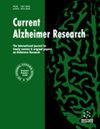Discrepancy between cognitive test and brain imaging results in Alzheimer's disease associated with diabetes.
IF 1.8
4区 医学
Q3 CLINICAL NEUROLOGY
引用次数: 0
Abstract
BACKGROUND/OBJECTIVE Although a large number of studies have been performed on the association between Alzheimer's disease (AD) and type 2 diabetes mellitus (DM), the underlying pathophysiology of AD associated with DM has not been fully elucidated to date. We compared cognitive functions and brain imaging findings between AD patients with and without DM to characterize the association between cognition and imaging findings in AD patients with DM. METHODS Cognitive functions and brain imaging findings, including medial temporal lobe atrophy analyzed by magnetic resonance imaging, and hypoperfusion in the parietal, posterior cingulate, and frontal regions analyzed by single-photon emission computed tomography were compared between 126 AD patients without DM ([AD-DM]) and 51 AD patients with DM ([AD+DM]). Factors associated with cognitive-imaging associations, including education, occupation, leisure activity, comorbidity, frailty, and other demographics, were analyzed. RESULTS The [AD+DM] group showed significantly more severe cognitive dysfunction than the [AD- DM] group, despite a similar degree of brain imaging abnormalities. Among the factors associated with cognitive-imaging associations, the level of leisure activity was significantly lower in the [AD+DM] group than in the [AD-DM] group, but no significant differences in other factors were observed between the 2 groups. CONCLUSION The cognitive-imaging discrepancy observed in AD patients with DM may be associated with their low cognitive reserve, possibly caused by their low amount of leisure activities. Our findings suggest that lifestyle interventions, including physical, cognitive, and social activities, may reduce cognitive decline in AD patients with DM.认知测试与脑成像结果在糖尿病相关的阿尔茨海默病中的差异
背景/目的尽管已经对阿尔茨海默病(AD)和2型糖尿病(DM)之间的关系进行了大量研究,但迄今为止,AD与DM相关的潜在病理生理学尚未完全阐明。我们比较了患有和不患有糖尿病的AD患者的认知功能和脑影像学表现,以表征患有糖尿病的阿尔茨海默病患者的认知和影像学表现之间的关系。方法认知功能和大脑影像学表现包括磁共振成像分析的内侧颞叶萎缩,以及顶叶、后扣带、,并比较了126例无糖尿病的AD患者([AD-DM])和51例有糖尿病的AD([AD+DM])通过单光子发射计算机断层扫描分析的额叶区域。分析了与认知成像相关的因素,包括教育、职业、休闲活动、共病、虚弱和其他人口统计数据。结果[AD+DM]组表现出比[AD-DM]组更严重的认知功能障碍,尽管脑成像异常程度相似。在与认知成像相关的因素中,[AD+DM]组的休闲活动水平显著低于[AD-DM]组,但两组之间在其他因素上没有观察到显著差异。结论AD合并DM患者的认知影像学差异可能与他们的低认知储备有关,可能是由他们的低休闲活动量引起的。我们的研究结果表明,生活方式干预,包括身体、认知和社交活动,可以减少糖尿病AD患者的认知能力下降。
本文章由计算机程序翻译,如有差异,请以英文原文为准。
求助全文
约1分钟内获得全文
求助全文
来源期刊

Current Alzheimer research
医学-神经科学
CiteScore
4.00
自引率
4.80%
发文量
64
审稿时长
4-8 weeks
期刊介绍:
Current Alzheimer Research publishes peer-reviewed frontier review, research, drug clinical trial studies and letter articles on all areas of Alzheimer’s disease. This multidisciplinary journal will help in understanding the neurobiology, genetics, pathogenesis, and treatment strategies of Alzheimer’s disease. The journal publishes objective reviews written by experts and leaders actively engaged in research using cellular, molecular, and animal models. The journal also covers original articles on recent research in fast emerging areas of molecular diagnostics, brain imaging, drug development and discovery, and clinical aspects of Alzheimer’s disease. Manuscripts are encouraged that relate to the synergistic mechanism of Alzheimer''s disease with other dementia and neurodegenerative disorders. Book reviews, meeting reports and letters-to-the-editor are also published. The journal is essential reading for researchers, educators and physicians with interest in age-related dementia and Alzheimer’s disease. Current Alzheimer Research provides a comprehensive ''bird''s-eye view'' of the current state of Alzheimer''s research for neuroscientists, clinicians, health science planners, granting, caregivers and families of this devastating disease.
 求助内容:
求助内容: 应助结果提醒方式:
应助结果提醒方式:


